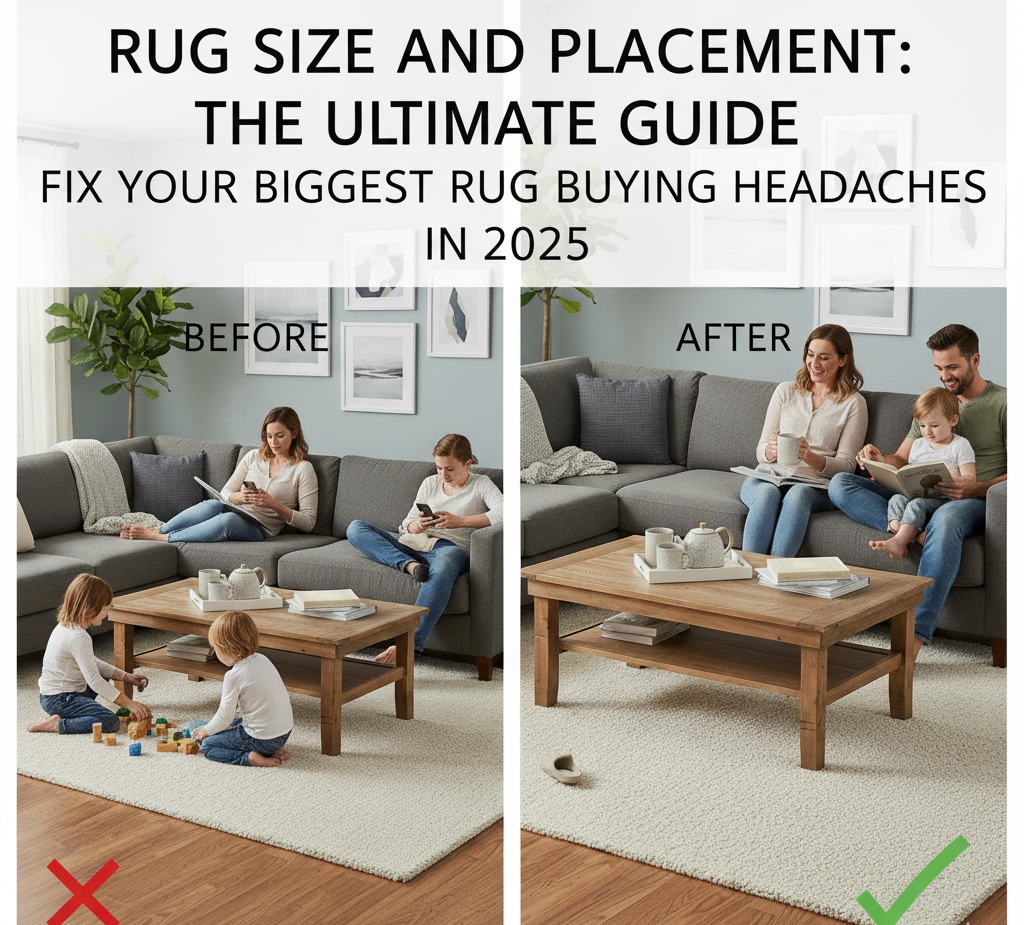Hey there, let’s chat about something that’s tripped up so many of us when we’re trying to make our homes feel just right—picking the perfect rug. I know that feeling all too well: You spot a gorgeous rug online or in a store, get all excited imagining it in your space, and then… it arrives, and it’s either drowning the room or looking like a sad little island in the middle of your floor. It’s frustrating, right? Like, why does something as simple as a rug have to be such a puzzle? But don’t worry, friend—I’ve been there, and after chatting with designers, scouring through buyer stories, and even fixing my own rug disasters, I’ve got your back. In this guide, we’re diving into the biggest rug headaches: nailing the standard sizes, getting that living room placement spot-on, choosing tough rugs for high-traffic spots, and sizing up your dining room without the guesswork. We’ll make it feel like we’re sitting down with coffee, sorting this out together, so you can finally get that cozy, put-together vibe you’ve been dreaming of. By the end, you’ll feel confident hitting “add to cart” on the rug that’s truly meant for your home.
Quick Look: Rug Sizing and Placement Essentials
To kick things off without overwhelming you, here’s a handy chart summarizing the key rug sizes for common rooms, what they’re best for, and a quick tip to avoid the most common pitfalls. Think of this as your cheat sheet before we dive deeper.
| Room/Area | Recommended Sizes | Best For… | Key Tip to Avoid Mistakes |
| Living Room | 8×10, 9×12, 10×14 | Anchoring furniture groupings | Ensure all front legs (or all legs) are on the rug; too small makes the room feel choppy. |
| Dining Room | 8×10 (4-6 chairs), 9×12 (6-8 chairs), 10×14 (8+ chairs) | Allowing chair pull-out without snags | Add 24-36 inches around the table; wrong shape can make the space feel awkward. |
| High-Traffic Areas (Entry/Hallway) | 3×5 or runners (2×8, 2×10) | Durable daily use without wear | Choose low-pile; oversized can bunch, undersized looks lost. |
| Bedroom | 5×8 (twin), 8×10 (queen), 9×12 (king) | Soft landing around the bed | Extend 18-24 inches beyond sides; too small leaves cold floors exposed. |
| Kitchen/Bath | 2×3, 3×5 (mats), 4×6 (larger) | Spot protection and coziness | Match to space shape; ignoring traffic leads to quick stains. |
Why Getting Rug Size and Placement Right Matters More Than Ever in 2025
Listen, rugs aren’t just about covering up ugly floors—they’re the unsung heroes that tie a room together, make it feel warmer, and even help with noise in those open-concept homes we’re all loving these days. But here’s the thing: In 2025, with more folks working from home and entertaining in multi-purpose spaces, a bad rug choice can throw off the whole vibe. From what I’ve seen in design trends and buyer feedback, searches for “rug size guide” and “living room rug placement” are skyrocketing because people are tired of wasting money on returns. Leading home decor sites like The Spruce and Wayfair report that over 40% of rug returns stem from size issues—too small makes rooms look disjointed, too big overwhelms, and wrong placement turns functional spaces into tripping hazards.
The good news? Designers are emphasizing practical, foolproof rules this year, focusing on sustainability and versatility. This has led to a rise in demand for machine-washable runners and low-VOC/recycled fiber large-area rugs. Rugs now come in more sizes and materials to fit odd layouts, but the core problems remain: misjudging scale, ignoring room shape, or not thinking about daily life. Whether you’re in a tiny apartment or a spacious house, getting this right isn’t about rules—it’s about making your home work for you, creating spots where you actually want to hang out. I’ve talked to folks who’ve regretted impulse buys, and trust me, solving these upfront saves headaches (and cash). Let’s break it down so you can shop smarter—our rug collection at thebohorugs.com has options that’ll fit just right once we sort this.
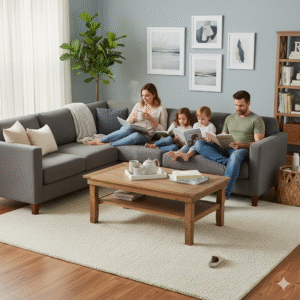
The Emotional Toll of Rug Regrets: Why It Hits Home (And How to Fix It)
Okay, let’s get real for a second—buying the wrong rug isn’t just a decor fail; it can make your home feel off, like it’s not quite “you.” I remember a friend who splurged on a beautiful patterned rug for her living room, only to realize it was way too small. The furniture looked like it was floating on an island, and she felt embarrassed hosting friends because the room seemed unfinished. It’s that sinking feeling when something you hoped would make your space cozy ends up highlighting the awkward bits instead. And for high-traffic areas? Picking a pretty but fragile rug turns into daily frustration—stains, wear, and constant cleaning that steals your peace.
But here’s the heart of it: A well-chosen rug can flip that script, turning chaotic rooms into welcoming havens where you love spending time. Designers I’ve chatted with say it’s about that emotional connection— the right size and placement make your home feel balanced, like everything’s in harmony. For families, it’s creating safe, comfy spots for play; for solo dwellers, it’s that cozy nook that says “relax.” The key? Addressing those big buyer pains head-on: overestimating size, ignoring traffic patterns, or skipping shape considerations. Stick with me—we’ll turn those “oh no” moments into “yes, this is perfect.”
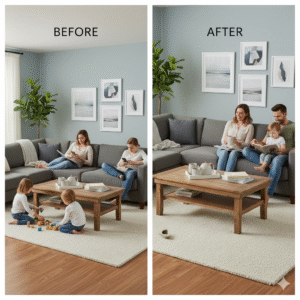
Top Rug Trends for 2025: From Practical to Patterned
Let’s pivot to what really matters: the core solutions to your rug woes. Based on common buyer struggles from sites like The Spruce and Rugs USA, here are the top four problem-solvers for 2025, with tips tailored to make your life easier.
1. Mastering the Standard Rug Size Guide: No More Guesswork
Rug sizes can feel like a maze, but sticking to standards simplifies everything. Common options include 2×3 (small accents), 3×5 (kitchen mats), 5×8 (bedside), 8×10 (living rooms), 9×12 (larger areas), and 10×14 (dining). The trick? Match to your room’s scale—too small chops up space, too big crowds it.
For example, in a standard 12×15 living room, an 8×10 fits most setups, covering the seating area without touching walls. Pro tip from Wayfair guides: Leave 12-18 inches of floor border around the rug for breathing room. If you’re dealing with odd shapes, round rugs (6-8 foot diameter) work wonders in square rooms. And for buyers on a budget? Start with versatile 5×8—it’s forgiving and easy to repurpose.
2. Living Room Rug Placement Tips: Get That Cozy Flow Right
Placement is where most folks stumble— a rug that’s off can make even pricey furniture look awkward. The golden rule? “Front legs on” for sofas and chairs, creating a unified grouping. For larger rooms, “all legs on” gives a luxurious feel, but ensure at least 8 inches under each piece to avoid tipping.
In open-concept spaces, use the rug to define zones—place it fully under the seating area, leaving walkways clear. Common fix: If your rug’s too small, layer a larger neutral underneath (like jute) for extension without buying new. From Overstock tips, rotate seasonally to prevent uneven wear from sun or foot traffic. It’s all about making your living room a spot you love lounging in, not one that feels disjointed. In 2025, minimalist, layered rugs are a top trend for versatility in multi-purpose rooms.
3. Best Rugs for High-Traffic Areas: Tough Choices That Last
High-traffic spots like entries or kitchens need rugs that can take a beating without losing style. Top picks? Low-pile synthetics like polypropylene or nylon—they’re stain-resistant, easy to clean, and hold up to daily chaos. Wool blends add softness but require more care; avoid high-pile shag here, as it traps dirt.
For durability, look for tight weaves (like loop or flatweave) that don’t snag. Sizes: Runners (2×8 or 2×10) for hallways, 3×5 mats for entries. Pro advice from Rugs USA: Choose dark patterns to hide footprints; test with a wet cloth for colorfastness. These choices mean less stress—your rug stays looking fresh, letting you focus on life, not scrubbing. In 2025, there’s a huge movement toward sustainable, low-pile recycled synthetics for durability and easy cleaning.
4. Choosing the Right Size Rug for the Dining Room: No More Chair Snags
Dining rooms demand rugs that let chairs glide smoothly—wrong size means constant catches or exposed floors. Rule of thumb: Add 24-36 inches around all sides of the table when chairs are pulled out. For a 4-6 seat rectangular table, 8×10 works; 6-8 seats need 9×12; larger groups, 10×14 or more.
Shape matters: Rectangular for rectangular tables, round for round (8-10 foot diameter). Common fix: If space is tight, measure with chairs out—better slightly oversized than under. From The Spruce, opt for low-pile to avoid bunching. This setup turns meals into enjoyable gatherings, not furniture fights.
Rugs in Every Room of the House: Tailored Solutions
- The Welcoming Entryway: 3×5 or runner for quick weatherproofing. Dark low-pile hides mud. Shop entryway rugs.
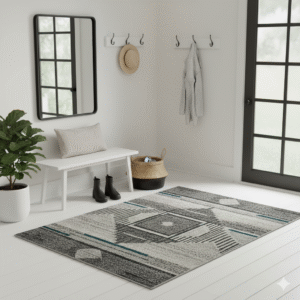
- The Cozy Living Room: 8×10+ with front legs on. Patterns add personality without clutter.
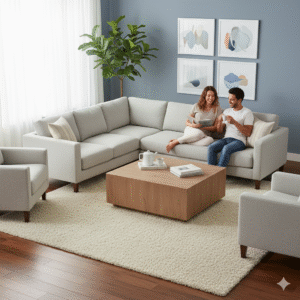
- The Busy Kitchen: 2×3 mats near sinks; synthetic for spills.
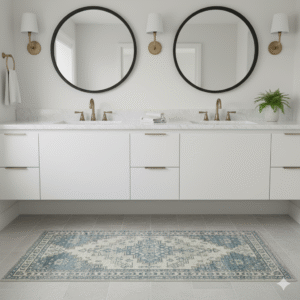
- The Serene Bedroom: 5×8+ extending around bed; soft wool for mornings.
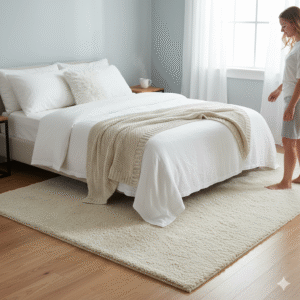
- The Functional Dining Room: 9×12 with chair room; flatweave for easy slide.
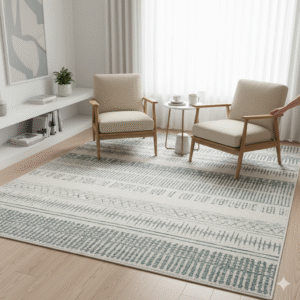
- The High-Traffic Hallway: Runners in nylon; stripes elongate space.
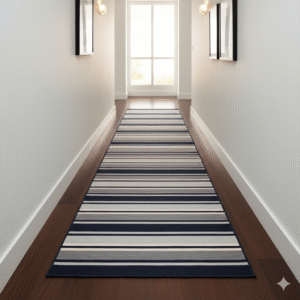
Common Mistakes to Avoid When Buying and Placing Rugs
I’ve seen these trip up even savvy shoppers—let’s dodge them together. First, buying too small: Rooms look unbalanced—always measure with furniture in mind. Second, ignoring shape: Square table on rectangular rug? Awkward—match for harmony. Third, skimping on material for traffic: Pretty shag in entries mats fast—go durable. Fourth, bad placement: Sun fades colors—use UV curtains. Fifth, forgetting rotation: Uneven wear ruins it—flip quarterly. Avoiding these turns “oops” into “oh, perfect!”
Frequently Asked Questions About Rug Sizing and Placement
Q: What’s the biggest rug sizing mistake?
A: Going too small! It makes rooms feel disconnected. Measure your furniture grouping and add 24 inches around for that pulled-together look.
Q: How do I place a rug in an open living room?
A: Define the seating zone—front legs on at least. For floating furniture, all legs on creates coziness. Test with tape first!
Q: Best rugs for high-traffic areas with kids/pets?
A: Low-pile synthetics like polypropylene—stain-resistant, easy clean. Dark patterns hide dirt; avoid wool if allergies are an issue.
Q: Right size for a 6-person dining table?
A: 9×12 rectangular; chairs need 24-30 inches pull-out room. Round tables? 8-9 foot diameter rug.
Q: Can I layer rugs if one is too small?
A: Yes! Neutral base under patterned top adds depth. Secure with tape to avoid slips
Wrapping Up: Your Rug Problems, Solved for Good in 2025
Friend, we’ve tackled those rug headaches head-on—from sizing secrets to placement perfection—and I hope it feels like we’ve figured this out together. Remember, the right rug isn’t just fabric; it’s what makes your home feel like you—cozy, functional, and full of heart. No more regrets or returns; now you’re set to create spaces where memories happen. What’s your biggest rug win or woe so far? Drop it in the comments—I’d love to chat and swap stories!
Ready to nail that perfect fit? Whether it’s a living room anchor or dining room dream, our 2025 Rug Collection at thebohorugs.com has the sizes and styles to solve it all. Shop now and find your ideal rug today.
About the Author
Aniket, founder of thebohorugs.com, is a passionate home decor enthusiast with over 10 years of experience curating modern and globally-inspired collections. Drawing from global travels and conversations with artisans, Aniket specializes in blending timeless trends with modern living to help you create spaces that tell your story.
This post draws from hands-on experience curating rug collections and conversations with industry pros to offer fresh, trustworthy guidance.
